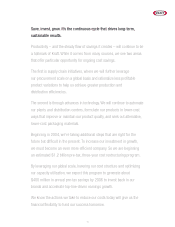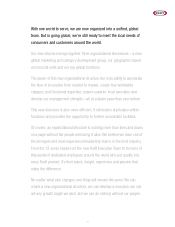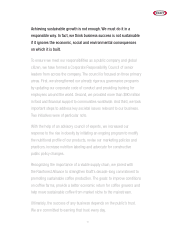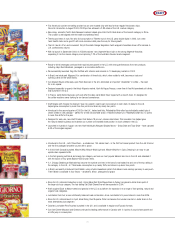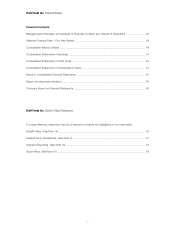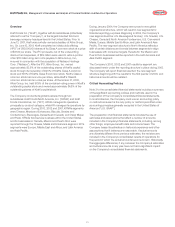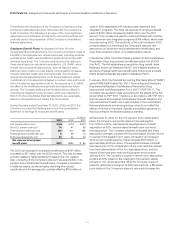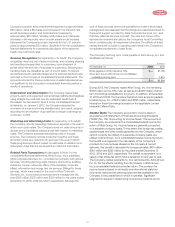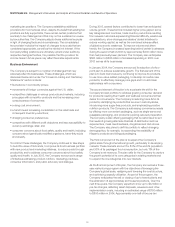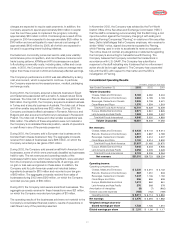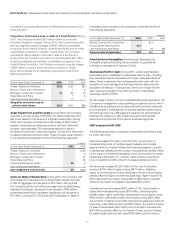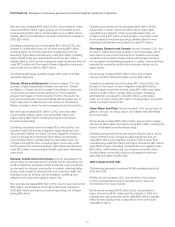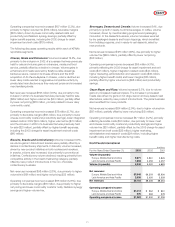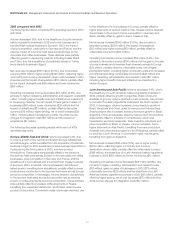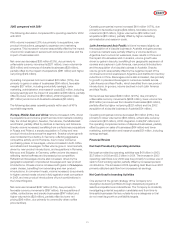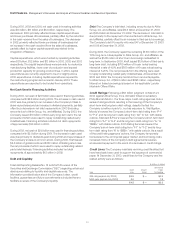Kraft 2003 Annual Report Download - page 26
Download and view the complete annual report
Please find page 26 of the 2003 Kraft annual report below. You can navigate through the pages in the report by either clicking on the pages listed below, or by using the keyword search tool below to find specific information within the annual report.
Kraft Foods Inc. Management’s Discussion and Analysis of Financial Condition and Results of Operations
The selection and disclosure of the Company’s critical accounting
policies and estimates have been discussed with the Company’s
Audit Committee. The following is a review of the more significant
assumptions and estimates, as well as the accounting policies and
methods used in the preparation of the Company’s consolidated
financial statements:
Employee Benefit Plans:As discussed in Note 14 to the
consolidated financial statements, the Company provides a range of
benefits to its employees and retired employees, including pensions,
postretirement health care benefits and postemployment benefits
(primarily severance). The Company records amounts relating to
these plans based on calculations specified by U.S. GAAP, which
include various actuarial assumptions, such as discount rates,
assumed rates of return on plan assets, compensation increases,
turnover rates and health care cost trend rates. The Company
reviews its actuarial assumptions on an annual basis and makes
modifications to the assumptions based on current rates and trends
when it is deemed appropriate to do so. As required by U.S. GAAP,
the effect of the modifications is generally amortized over future
periods. The Company believes that the assumptions utilized in
recording its obligations under its plans, which are presented in
Note 14 to the consolidated financial statements, are reasonable
based on its experience and advice from its actuaries.
During the years ended December 31, 2003, 2002 and 2001, the
Company recorded the following amounts in the consolidated
statement of earnings for employee benefit plans:
(in millions)
2003 2002 2001
U.S. pension plan income $(46) $(33) $(227)
Non-U.S. pension plan cost 74 47 35
Postretirement healthcare cost 229 217 199
Postemployment benefit plan cost 635 12
Employee savings plan cost 84 64 63
Net expense for employee
benefit plans $347 $330 $ 82
The 2003 net expense for employee benefit plans of $347 million
increased by $17 million over the 2002 amount. This cost increase
primarily relates to higher settlement losses in the U.S. pension
plan, a lowering of the Company’s discount rate assumption on its
pension and postretirement benefit plans, increased amortization
of deferred losses, as well as higher matching of employee
contributions in the savings plan, partially offset by $148 million of
costs in 2002 associated with voluntary early retirement and
integration programs. The 2002 net expense for employee benefit
plans of $330 million increased by $248 million over the 2001
amount. This increase includes the costs associated with voluntary
early retirement and integration programs ($148 million), which were
recorded during 2002. The remainder of the cost increase in 2002
primarily relates to a lowering of the Company’s discount rate
assumption on its pension and postretirement benefit plans, and
lower than expected returns on invested pension assets.
In December 2003, the United States enacted into law the Medicare
Prescription Drug, Improvement and Modernization Act of 2003
(the “Act”). The Act establishes a prescription drug benefit under
Medicare, known as “Medicare Part D,” and a federal subsidy to
sponsors of retiree health care benefit plans that provide a benefit
that is at least actuarially equivalent to Medicare Part D.
In January 2004, the Financial Accounting Standards Board (“FASB”)
issued FASB Staff Position No. 106-1, “Accounting and Disclosure
Requirements Related to the Medicare Prescription Drug,
Improvement and Modernization Act of 2003” (“FSP 106-1”). The
Company has elected to defer accounting for the effects of the Act,
as permitted by FSP 106-1. Therefore, in accordance with FSP 106-1,
the Company’s accumulated postretirement benefit obligation and
net postretirement health care costs included in the consolidated
financial statements and accompanying notes do not reflect the
effects of the Act on the plans. Specific authoritative guidance on
the accounting for the federal subsidy is pending.
At December 31, 2003, for the U.S. pension and postretirement
plans, the Company reduced its discount rate assumption
from 6.5% to 6.25%, maintained its expected return on asset
assumption at 9.0%, and increased its health care cost trend
rate assumption. The Company presently anticipates that these
assumption changes, coupled with the amortization of lower returns
on pension fund assets in prior years, will result in an increase in
2004 pre-tax benefit expense of approximately $130 million, or
approximately $0.05 per share. The expected increase in benefit
expense is prior to the consideration of any cost reduction derived
from the implementation of the Act, discussed above, and any
impact of the three-year restructuring program announced in
January 2004. The Company’s long-term rate of return assumption
remains at 9.0% based on the investment of its pension assets
primarily in U.S. equity securities. While the Company does not
presently anticipate a change in its 2004 assumptions, a fifty-basis-
point decline in the Company’s discount rate would increase the
24



